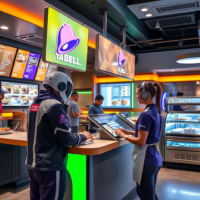Introduction: Taco Bell’s Legacy of Innovation
Taco Bell has long been synonymous with bold flavors and disruptive marketing. From the iconic Doritos Locos Tacos to viral social media campaigns, the brand thrives on innovation. Now, Taco Bell is making headlines again with its latest venture: an AI-powered “coach” designed to streamline operations, personalize customer interactions, and solidify its position as a tech-forward leader in the fast-food industry. This move follows a significant digital tech investment, signaling a strategic shift toward leveraging artificial intelligence to drive growth.
In this blog, we’ll explore the details of Taco Bell’s AI coach, its implications for the brand, and how it fits into the broader trend of AI adoption in quick-service restaurants (QSRs).
Chapter 1: Taco Bell’s Digital Transformation Journey
From Crunchwraps to Code: A Tech Evolution
Taco Bell’s digital investments began years ago with mobile ordering, self-service kiosks, and loyalty programs. The brand’s app, which boasts millions of users, laid the groundwork for data-driven personalization. Recent investments, however, mark a quantum leap:
- $500M+ Tech Budget: Allocated over three years to overhaul backend systems, AI integration, and customer-facing tech.
- Partnerships with Tech Giants: Collaborations with companies like Microsoft and Google for cloud computing and AI solutions.
- Focus on Speed and Convenience: Aligning with consumer demand for faster service and frictionless experiences.
Key Milestones:
- 2020: Launch of AI-driven drive-thru menus that adapt to time of day and traffic patterns.
- 2022: Pilot of kitchen automation tools to reduce wait times.
- 2023: Full rollout of the AI coach across select locations.
Chapter 2: The Role of AI in Modern Fast Food
Why AI? The QSR Industry’s Digital Awakening
The fast-food sector faces mounting pressure to balance speed, quality, and personalization. AI offers solutions across three pillars:
- Customer Experience: Chatbots, personalized recommendations, and dynamic menu pricing.
- Operational Efficiency: Predictive inventory management, labor optimization, and kitchen automation.
- Data-Driven Decisions: Analyzing customer behavior to inform menu updates and marketing strategies.
Competitors’ AI Moves:
- McDonald’s: Acquired AI startup Dynamic Yield for drive-thru customization.
- Domino’s: Uses AI for pizza tracking and predictive ordering.
- Starbucks: Leverages AI for inventory and barista task management.
Taco Bell’s AI coach aims to outpace competitors by integrating these functions into a unified system.
Chapter 3: Introducing the AI Coach – Features and Capabilities
What Exactly Is the AI Coach?
The AI coach is a multifaceted platform that acts as a virtual assistant for both employees and customers. Here’s how it works:
1. Front-of-House Enhancements
- Personalized Ordering: Uses past purchase data to suggest menu items (e.g., “Craving Crunchy Tacos? Try the new Diablo version!”).
- Voice-Activated Kiosks: Reduces friction for customers uncomfortable with touchscreens.
- Dynamic Pricing: Adjusts prices in real-time based on demand, weather, or inventory.
2. Back-of-House Efficiency
- Predictive Inventory: Alerts managers to restock ingredients before shortages occur.
- Kitchen Workflow Optimization: Assigns tasks to staff based on skill level and order volume.
- Waste Reduction: Analyzes trends to minimize food waste.
3. Employee Support
- Training Modules: VR simulations for new hires powered by AI feedback.
- Real-Time Assistance: Provides step-by-step guidance during peak hours.
4. Marketing and Loyalty
- Hyper-Personalized Campaigns: Sends tailored offers via the Taco Bell app.
- Sentiment Analysis: Monitors social media to gauge public perception and adjust strategies.
Chapter 4: Benefits of the AI Coach for Taco Bell
1. Enhanced Customer Experience
- Faster service times and fewer errors.
- Tailored recommendations boost average order value.
2. Operational Cost Savings
- Reduced labor costs through task automation.
- Lower food waste = higher profit margins.
3. Data Goldmine
- Insights into consumer preferences enable agile menu innovation (e.g., testing regional items).
4. Competitive Edge
- Positions Taco Bell as a tech innovator, attracting younger, digitally savvy customers.
Chapter 5: Challenges and Criticisms
Addressing the Elephant in the Room
While the AI coach offers numerous benefits, challenges remain:
- Privacy Concerns: How customer data is stored and used.
- Job Displacement Fears: Balancing automation with human employment.
- Tech Reliability: Potential glitches during peak hours could frustrate customers.
Taco Bell’s response:
- Emphasizing that AI augments, not replaces, human workers.
- Committing to transparent data practices.
- Phased rollout to troubleshoot issues.
Chapter 6: Industry Implications and Future Trends
Setting a New Standard for QSRs
Taco Bell’s AI coach could inspire competitors to accelerate their own tech investments. Key trends to watch:
- AI-Powered Menus Become Standard: Dynamic pricing and recommendations may soon be industry norms.
- Hybrid Workforce Models: More restaurants will blend AI tools with human staff.
- Sustainability Through Tech: AI-driven waste reduction could help brands meet ESG goals.
What’s Next for Taco Bell?
- Expansion of AI coach to all U.S. locations by 2025.
- Potential integration with autonomous delivery drones or robots.
- Global rollout in markets like India and Europe.
Conclusion: Taco Bell’s AI Coach – A Glimpse into the Future
Taco Bell’s AI coach isn’t just a tech upgrade—it’s a bold step toward redefining the fast-food experience. By marrying creativity with cutting-edge technology, the brand is poised to lead the QSR industry into an AI-driven era. As consumers increasingly prioritize convenience and personalization, Taco Bell’s investment underscores a critical truth: the future of fast food is smart, efficient, and deliciously innovative.

